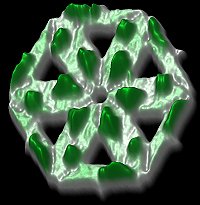Researcher Finds Easy Way Of Producing Nano Structures And Devices
A nanotechnologist has created the world's smallest and most plentiful smiley, a tiny face measuring a few billionths of a metre across assembled from strands of DNA.
Dr Paul Rothemund at the California Institute of Technology can make 50 billion smileys, each a thousand times smaller than the diameter of a human hair, with his technique.
DNA has long been known for its versatility as a microscopic building block.
The molecule can be 'cut' using enzymes and reassembled using matching rungs in its double-helix structure.
This theoretically opens the way to making DNA quantum computers and nano-level devices including injectable robots that can monitor the body's tissues for good health.
But, until now, nano-assembly has been a complex atom-by-atom procedure that is also costly, because it is carried out in a vacuum or at extremely coldly temperatures.
Rothemund, writing in today's issue of the journal Nature, describes a far simpler and much cheaper process in which long, single strands of DNA can be folded back and forth to form a basic scaffold.
...
Rothemund has been working on flat, two-dimensional shapes but says that 3D structures in DNA should be quite feasible with this technique.
One application would be a nano-scale 'cage' in which pharmaceutical researchers, working on novel drugs, could sequester enzymes until they were ready for use in turning other proteins on and off.

Nano smiley

Nano hexagon
Every year, it gets a lot easier to build structures and devices at the nanoscale.
CRNano and other experts are predicting full blown nanofactories at around 2015.
Before you know it, you're living in a world where nanobots routinely repair damage in our bodies and keep us healthy indefinately, as envisioned by Eric Drexler in his book Engines Of Creation.
No comments:
Post a Comment